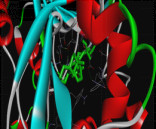Momordica charantia Fruit Extract on Cardiac Biomarker Serum Attenuation in Rats and its Bioactive Compound Molecular Docking Against SIRT-1 Protein http://www.doi.org/10.26538/tjnpr/v7i1.21
Main Article Content
Abstract
Momordica charantia has various biological activities as antihyperglycemic, anti-inflammatory, and antioxidant. Thisstudy evaluated Momordica charantia fruit extract against the LDH and CKMB serum in rats induced with isoproterenol. We also evaluated the molecular docking of bioactive compounds in Momordica charantia fruit against the SIRT1 protein. Wistar male rats were divided into four groups: negative control (Na-CMC), positive control (Na-CMC and isoproterenol), and resveratrol group at 9 mg/kg b.wt, and Momordica charantia fruit extract at 300 mg/kg b.w with isoproterenol. The interaction between ligand and receptor was evaluated and calculated with molecular docking software. The ligands were docked using the AutoDock Tools - 1.5.7. The binding affinity was calculated using the binding free energy (kcal/mol). The results showed that Momordica charantia fruit extract at 300 mg/kg b.w could attenuate the LDH (49.37%) and CKMB (44.5%) increase in serum after isoproterenol-induced myocardial infarction in rats. Molecular docking of selected compounds from Momordica charantia fruit extract presents that momordicilin has great potential as a SIRT-1 activator with a binding energy of - 11.3 kcal/mol. These findings implicate that Momordica charantia fruit extract can be developed further as a potential cardioprotective drug.
Downloads
Article Details

This work is licensed under a Creative Commons Attribution-NonCommercial-NoDerivatives 4.0 International License.
References
Severino P, D´Amato A, Pucci M. Ischemic Heart Disease and Heart Failure: Role of Coronary Ion Channels. Int J Mol Sci. 2020; 21:3167.
Palasubramaniam J, Wang X, Peter K. Myocardial Infarction: From Atherosclerosis to Thrombosis. Arterio, Thromb, and Vasc Biology. 2019; 39:e176–e185.
Morakinyo AE, Omoniyu FE, Nzekwe SC. Antioxidant, Anti-hyperlipidemic and Cardioprotective Potentials of Diet Supplemented with Parkia biglobosa Roasted Seeds on Isoproterenol-Induced Cardiotoxicity in Wistar rats. Trop J. Nat Prod Res. 2022; 6: 1882–1887.
Bachheti RK, Worku LA, Gonfa YH. Prevention and Treatment of Cardiovascular Diseases with Plant Phytochemicals: A Review. Evid-Bas Comp and Alt Med;2022: e5741198.
Effect of Aqueous Extract of Momordica charantia on Survival, Locomotive Behaviour and Antioxidant Status of Drosophila melanogaster. Trop J. Nat Prod Res. 2021; 5: 178–181.
Upadhyay A, Agrahari P, Singh DK. A Review on Salient Pharmacological Features of Momordica charantia. Int J. of Pharm. 2015; 11:405-413.
Grover JK, Yadav SP. Pharmacological actions and potential uses of Momordica charantia: a review. J Ethnopharmacol. 2004; 93:123-132.
Bortolotti M, Mercatelli D, Polito L. Momordica charantia, a Nutraceutical Approach for Inflammatory Related Diseases. Front in Pharm. 2019; 10.
Innih SO, Eze IG, Omage K. Cardiovascular benefits of Momordica charantia in cholesterol-fed Wistar rats. Clin Phyto. 2021; 7: 65.
Jandari S, Ghavami A, Ziaei R. Effects of Momordica charantia L on blood pressure: a systematic review and metaanalysis of randomized clinical trials. Int J. of Food Prop. 2020; 23:1913-1924.
Zhang J, Wang W, Liu T, Wang Y, Wei X, Qi S, Gu B. Effects of Momordica charantia exosomes on platelet activation, adhesion, and aggregation. Blood Coagul Fibr. 2022; 33: 372–380.
Patel R, Mahobia N, Upwar N, Waseem N, Talaviya H, Patel Z. Analgesic and antipyretic activities of Momordica charantia Linn. fruits. J Adv Pharm Technol Res. 2010; 1:415–418.
Salminen A, Kaarniranta K, Kauppinen A. Crosstalk between Oxidative Stress and SIRT1: Impact on the Aging Process. Int J. of Mol Sci. 2013; 14:3834–3859.
Ren Z, He H, Zuo Z, Xu Z, Wei Z, Deng J. The role of different SIRT1-mediated signaling pathways in toxic injury. Cell Mol Biol Lett; 2019: 24: 36.
Singh CK, Chhabra G, Ndiaye MA, Garcia-Peterson LM, Mack NJ, Ahmad N. The Role of Sirtuins in Antioxidant and Redox Signaling. Antioxid Redox Sig. 2018; 28:643–661.
Alam F, Syed H, Amjad S, Baig M, Khan TA, Rehman R.Interplay between oxidative stress, SIRT1, reproductive and metabolic functions. Cur Res in Phys. 2021; 4: 119–124.
Donmez G, Outeiro TF. SIRT1 and SIRT2: emerging targets in neurodegeneration. EMBO Mol Med. 2013; 5:344–352.
Manjula R, Anuja K, Alcain FJ. SIRT1 and SIRT2 Activity Control in Neurodegenerative Diseases. Front Pharmacol. 2020; 11:585821.
Elibol B, Kilic U. High Levels of SIRT1 Expression as a Protective Mechanism Against Disease-Related Conditions. Front in End. 2018; 9:1-7.
Hung LM, Chen JK, Huang SS, Lee RS, Su MJ. Cardioprotective effect of resveratrol, a natural antioxidant derived from grapes. Cardiovasc Res. 2000; 47: 549–555.
Murugesan, M. Cardioprotective effect of fenugreek on isoproterenol-induced myocardial infarction in rat. Indian J. Pharm. 2011; 5:516-519.
Makisake RG, Montolalu RI, Mewengkang HW. Studi In Silico Senyawa Aktif Daun Tagalolo (Ficus septica Burm F) sebagai Ligan Uji pada Enzim L-Histidin Decarboxylase. Med Tek H Peri. 2022; 10: 122–126.
Abel P, Rorabaugh B. Isoproterenol. in xPharm: The Comprehensive Pharmacology Reference (eds. Enna, S. J. & Bylund, D. B.). Elsevier. 2007; 1-7. Doi:10.1016/B978-008055232-3.63729-8.
Kurniati NF, Nathania J, Prasesti GK. Cardioprotective Activity of Combination of Soursop Leaves (Annona Muricata L.) and Avocado Seeds (Persea Americana Mill.) on Isoproterenol-Induced Myocardial Infarction in Rats. Egypt J of Chem. 2022; 65: 173–179.
Amani M, Jeddi, Sajad, Ahmadiasl N, Usefzade N, Zaman J. Effect of HEMADO on Level of CK-MB and LDH Enzymes after Ischemia/Reperfusion Injury in Isolated Rat Heart. Bioimpacts. 2013; 3: 101–104.
Aydin S, Ugur K, Aydin S, Sahin İ, Yardim M. Biomarkers in acute myocardial infarction: current perspectives. Vasc Health Risk Manag. 2019; 15: 1–10.
Czompa A, Gyongyosi A, Szoke K, Bak I, Csepanyi E. Effects of Momordica charantia (Bitter Melon) on Ischemic Diabetic Myocardium. Molecules. 2017; 22:1-15.
Raish, M. Momordica charantia polysaccharides ameliorate oxidative stress, hyperlipidemia, inflammation, and apoptosis during myocardial infarction by inhibiting the NF-κB signaling pathway. Int J. of Bio Macro. 2017; 97:544–551.
Matsushima S, Sadoshima J. The role of sirtuins in cardiac disease. Am J Physiol Heart Circ Physiol. 2015; 309: H1375–H1389.
Hoare, S. R. J. 1.10 - Kinetics of Drug-Target Binding: A Guide for Drug Discovery. in Comprehensive Pharmacology(ed. Kenakin, T.) Elsevier. 2022; 227–271. Doi:10.1016/B978-0-12-820472-6.00011-6.


